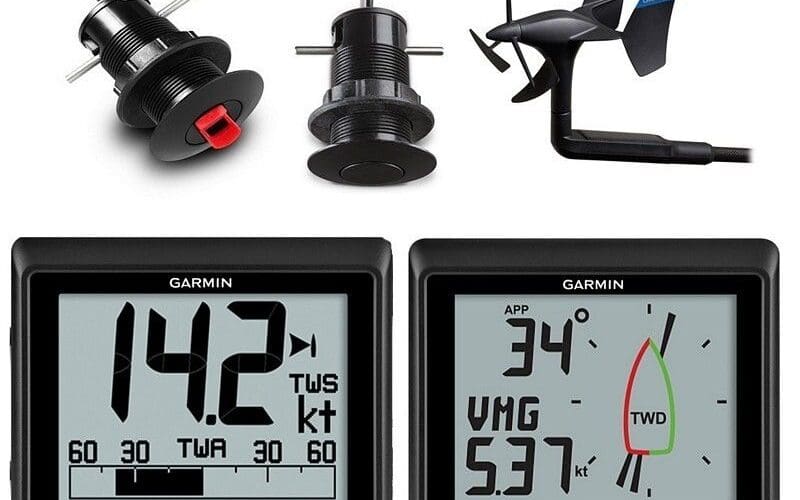by Bill Morris
 Whether you are racing or cruising, knowing your precise wind speed and direction while underway contributes greatly to sailing strategy as you count down the miles remaining to your destination. But before you run to your local chandlery to select a digital or analog wind sensor and display, consider the wide array of options in these systems and find the package best suited to your needs.
Whether you are racing or cruising, knowing your precise wind speed and direction while underway contributes greatly to sailing strategy as you count down the miles remaining to your destination. But before you run to your local chandlery to select a digital or analog wind sensor and display, consider the wide array of options in these systems and find the package best suited to your needs.
Some wind indicators are available as stand-alone units while others are included as part of a larger kit, which may include a thru-hull depth finder with transducer and a GPS receiver with antenna. Installation kits generally include a lengthy list of parts, so make sure the set is complete before you embark on the installation.
The Garmin GNX Sail Pack is a popular option for sailors looking for a dependable, high-quality, reasonably priced navigation instrument array. The GNX Wind Instrument, available as part of the larger package, consists of a glass monochrome LCD display with several backlit colors to choose from. The Wind Instrument indicates true and apparent wind direction and speed, steering feedback, vessel speed and other data.
Garmin’s gWind Wireless 2 Transducer features a three-bladed propeller with Nexus twin-fin technology, which transmits wind data from the masthead (up to 50 feet) to the display at the helm. The entire kit, which communicates via NMEA 2000 network, includes a ST810 thru-hull Smart Transducer and GNX 20 color display. The whole Garmin GNX Wireless Sail Pack installation kit is available through the GPS Store online for a very reasonable $1,000.
The B&G WS320 wireless wind sensor, like several other navigation sets on the market, is available as part of a package, which includes a DST810 Multisensor thru-hull transducer, a ZG100 GPS antenna and a micro-C backbone kit running on a NMEA 2000 Micro-C network.
The WS320 wind sensor is designed to support crew with uninterrupted data, which includes apparent wind speed and angle data reported at a speed of five times per second. The B&G DST210 thru-hull combination sensor measures speed with a paddle wheel, depth with a transducer and temperature with a reliable, submerged thermometer.
Completing the B&G package is a ZG100 GPS antenna, which provides B&G chartplotters with fast, reliable, 10-Hz position data. The whole ensemble, including the NMEA 2000 Micro-C network backbone kit, is available at West Marine for $1,600.
 If you are looking for a traditional stand-alone wind indicator, consider the Signet SL254 Wind Instrument. This is an analog wind sensor with a mechanical dial indicating wind direction and a small LCD screen showing wind speed. Framed in a gloss black bezel, the SL254 pairs with a Signet SL172 depth sounder and SL267A knot meter, which feature the same bezel.
If you are looking for a traditional stand-alone wind indicator, consider the Signet SL254 Wind Instrument. This is an analog wind sensor with a mechanical dial indicating wind direction and a small LCD screen showing wind speed. Framed in a gloss black bezel, the SL254 pairs with a Signet SL172 depth sounder and SL267A knot meter, which feature the same bezel.
Included with the SL254 Wind Instrument are a masthead sensor assembly and an 80-foot mast cable with mounting kit, all available directly from Signet in Redondo Beach, Calif. At a price of $1,235 for the complete installation package, the Signet SL254 Wind Instrument is certainly not a budget device, but sailors regard it as a dependable, accurate piece of navigation equipment.
As fellow cruising sailors, we all want dependable navigation systems, particularly wind indicators, guaranteed to serve us with ease of use and through many thousands of miles of flawless performance. Stay on track by choosing the wind sensor best suited to your sailing style and navigation needs.
Circumnavigator-author Bill Morris believes the best strategy for succeeding as an offshore voyager is to keep systems simple and, if possible, manual. Key to survival are a windvane self-steering system, a basic array of electronics and an aggressive alternative energy battery charging matrix. Bill is a Contributing Editor to Ocean Navigator and the author of The Windvane Self-Steering Handbook (International Marine, 2004) and The Captain’s Guide to Alternative Energy Afloat (Seaworthy Publications, 2019).

